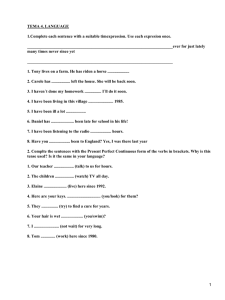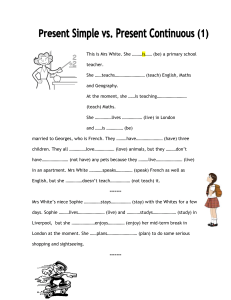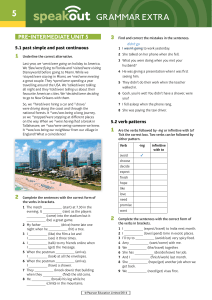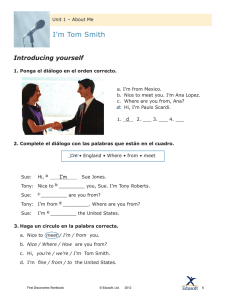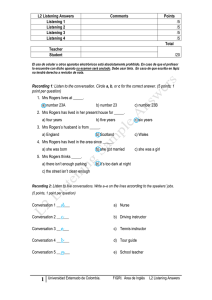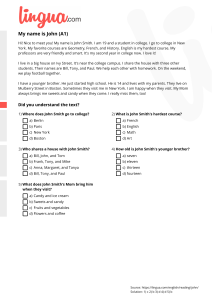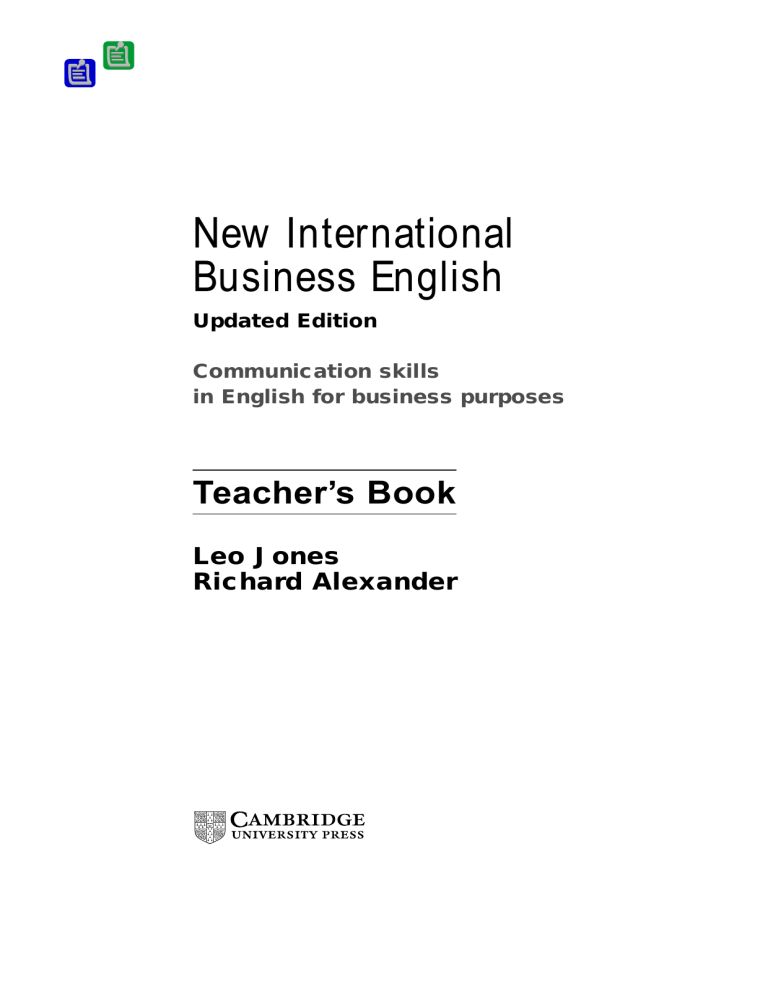
New International Business English Updated Edition Communication skills in English for business purposes Teacher’s Book Leo Jones Richard Alexander PUBLISHED BY THE PRESS SYNDICATE OF THE UNIVERSITY OF CAMBRIDGE The Pitt Building, Trumpington Street, Cambridge, United Kingdom CAMBRIDGE UNIVERSITY PRESS The Edinburgh Building, Cambridge CB2 2RU, UK www.cup.cam.ac.uk 40 West 20th Street, New York, NY 10011–4211, USA www.cup.org 10 Stamford Road, Oakleigh, Melbourne 3166, Australia Ruiz de Alarcón 13, 28014 Madrid, Spain © Cambridge University Press 1989, 1996, 2000 First published 1989 New Edition 1996 Updated Edition 2000 Some of the names of companies and individuals in this book are fictitious. In these cases any resemblance to an actual company or person is coincidental. Printed in the United Kingdom at the University Press, Cambridge Typeface Sabon 10.5/12pt. System QuarkXpress® A catalogue record for this book is available from the British Library ISBN ISBN ISBN ISBN ISBN ISBN ISBN ISBN ISBN ISBN ISBN ISBN ISBN ISBN 0 0 0 0 0 0 0 0 0 0 0 0 0 0 521 521 521 521 521 521 521 521 521 521 521 521 521 521 77471 77472 77469 77468 77470 77466 77467 77441 77443 77442 42735 42732 42734 42733 3 Teacher’s Book 1 Student’s Book 1 Student’s Book Cassette Set 3 Student’s Book Audio CD Set 5 Workbook 7 Workbook Cassette Set 5 Workbook Audio CD Set 1 New Video Cassette (VHS PAL) 8 New Video Cassette (VHS NTSC) X New Video Cassette (VHS SECAM) 5 Video Teacher’s Guide 0 Video Cassette (VHS PAL) 7 Video Cassette (VHS NTSC) 9 Video Cassette (VHS SECAM) Copyright It is normally necessary for written permission for copying to be obtained in advance from the publisher. The ‘Extra activities’ and ‘Model answers’ in this book are designed to be copied and distributed in class. The normal requirements are waived here and it is not necessary to write to Cambridge University Press for permission for an individual teacher to make copies for use within his or her own classroom. Only those pages which carry the wording ‘© Cambridge University Press 2000’ may be copied. Contents 4 6 Thanks Introduction About the course: Who the course is for, ‘Business English’, Active focus on business 6 How the course is organized: Units 1 to 4, Units 5 to 14, Unit 15 8 Types of activities and exercises: Integrated activities, Role-play, Files, Guide to the Files in the Student’s Book, Listening, Reading, Writing, Discussion and follow-up, Functions, Vocabulary, Extra activities Mistakes and correction, Written work 16 Background information for the non-business person 17 Using New International Business English, The Teacher’s Book, The Workbook, Home study 17 The New International Business English Video 19 1 Face to face 9 20 Basic skills and techniques for talking to people in business situations 2 Letters, faxes and memos 35 Basic skills and techniques for business correspondence 3 On the phone 45 Basic skills and techniques for using the telephone in business 4 Summaries, notes, reports 58 Basic skills and techniques for writing reports, making notes, summarizing and taking notes of conversations in business 5 Working together 70 Talking about where you work, employment policy, a company’s activities, organization and history 6 International trade 83 Ordering and supplying goods or services; answering and making enquiries, making offers, placing and acknowledging orders 7 Money matters 98 Methods of payment, cash flow, invoicing, dealing with non-payment problems 8 Dealing with problems 110 Complaining and apologizing, delivery and after-sales problems 9 Visitors and travellers 126 Looking after foreign visitors and travelling on business; hotels, restaurants, small talk, telling stories 10 Marketing 142 Marketing a product, market research, promotion and advertising 11 Meetings 153 Taking part in formal and informal meetings, one-to-one meetings and larger group meetings 12 Processes and operations 162 Explaining and describing operations, giving instructions 13 Jobs and careers 174 Applying for jobs and seeking promotion, participating in interviews 14 Sales and negotiation 187 Selling and buying products, negotiating face-to-face and on the phone 15 A special project 201 A simulation, revising many of the skills and situations in the course 3 1 Face to face To some extent, this unit can be considered as a ‘comfortable introduction’ to the rest of the course – it also introduces the types of exercises and activities that students will be doing during the course and shows the degree of student autonomy expected. But this is not just a ‘getting to know your classmates’ unit: the emphasis throughout is on encouraging students to consider and re-evaluate the social functions of English. In business, this is particularly important, as students may be dealing with all kinds of people in English: clients and colleagues, friends and strangers, superiors and subordinates – all of whom have to be talked to in different ways. The whole of Unit 1 comprises material for about four 11/2 hour lessons. We have given approximate timings for every section in the book, based on a ‘standard’ 90 minute ‘double lesson’. If your timetable is divided into shorter lessons, it will take you two of these to cover the same ground – where to make the break between lessons is up to you in this case. Some sections take ‘about 45 minutes’. These timings are approximate and, depending on the level of your students and what interests them, you should be prepared to take more time over some sections – and if necessary skip some steps altogether. This and the other three introductory units are ‘compulsory’ for students without work experience. But work-experienced students should also go through them, perhaps more quickly, before they start Unit 5. This is because many of the language skills taken for granted in Unit 5 onwards are introduced and practised in Units 1 to 4. The teaching notes for this unit are much more detailed than subsequent units. This is because we’re introducing some of the methods and ideas underlying the course. It’s advisable to read the notes through before each lesson. Background information For students who have no first-hand experience of business the Workbook contains Background information on the topic of meeting people and developing relationships. Draw their attention to this section in their Workbooks. Video Programme 1 on the New International Business English Video introduces the theme of this unit. 1.1 First impressions … This section introduces the idea that, in business life, it’s important not just to be efficient and do your job but also to look and sound friendly, confident, sincere and helpful … and not unfriendly, insincere, shy or unhelpful! People in different countries have different ideas of what sounds friendly, polite or sincere. Further aspects of the way in which people behave differently in different cultures are developed in 1.2 and 20 Unit 1 Face to face 1.4. In 1.1 we focus more on verbal behaviour and smiling; 1.4 focuses more on nonverbal behaviour: gestures, paralanguage and body language. This section also covers first meetings, establishing contact with people and taking the first steps in developing a relationship, which is taken further in 1.5. By approaching the topic through students’ everyday experiences the aim is to sensitize them to the need for friendliness, TACT and ‘smoothness’, which are needed in business dealings. Some students need to be made aware of how their ‘natural’ way of talking might sound to a native speaker of English – some nationalities (e.g. some Cantonese speakers and some German speakers) may sound rather abrupt or rude to speakers of other languages. Some students may need to make a considerable effort to smile more than usual and be extra polite to compensate for the way their tone of voice sounds to a foreigner! Vocabulary In each section of the Teacher’s Book you’ll find a list of important Vocabulary items: these lexical items are business and non-business terms that are introduced in the section, some of which students may not have come across before. Your students may be unfamiliar with the following words and expressions in this section. You may need to explain some of them – or you may prefer to ask the members of the class who do understand them to explain them to the others. Or you may prefer to wait until your students ask you to explain them. Students should highlight the items they want to remember in their own books – this means vocabulary which is new to them as well as words and phrases they already understand but which they (or you) feel they should try to use more often in their own speech. Among the items in the list will be some which are less relevant to your students, or which they don’t really need to remember and use – as well as many that some or all of them already do know and use. visitor sincere Whereabouts …? (un)welcoming aggressive head of department appointment co-ordinator small talk efficient sales office superior And in the Files for step E: 1 surname personnel badge public relations vice-chairman colleague – But, if possible get your students to choose a job title they do understand, rather than one they don’t! 31 Many of the place names (Geneva, Milan, etc.) will be different in English from your students’ language. 1.1 First impressions … 21 First of all If the members of the class are together for the first time, get everyone to introduce themselves by answering these questions: What’s your name? Where are you from? Where do you work? What do you do? or What are you studying? Why are you doing this course? My name’s … I’m from … I work in … I’m a … I’m studying … Because … Remind everyone that we usually answer the question: What do you do? by saying: I’m a student. or I’m an export clerk. or I’m a secretary. Introduce yourself in the same way too. Don’t spend too long on this, as students will be talking in more detail about the kind of work they do in 1.3. If everyone already knows everyone else, start straight in with the recording. Procedure – about 90 minutes A This is a warm-up activity. If your students already know each other, and you haven’t done the ‘First of all’ activity above, this step might be a good whole-class activity. At the end, try to reach a consensus as to which person looks the most welcoming and which the least. B Play the recording. Perhaps point out that the people greeting the visitors are not all receptionists, some are people who happen to be in the office when the visitor arrives – a situation all members of the class may find themselves in. We suggest that you play the recording through three times, though you may wish to pause between each brief interaction for your students to make comments and ask questions. 1 Play the recording all the way through so that students can imagine each of the situations, get used to the voices and get the gist of what is being said. 2 Play the recording again and this time ask everyone to decide on their answers to the questions in the Student’s Book. Then get everyone to discuss their answers. Why did some speakers sound more friendly or efficient than others? Was it the language they used or their tone of voice or what? (The man in extract 5 and the woman in extract 9 are particularly impolite.) 3 Finally, play the recording for a third time and ask them just to sit back and listen. Maybe they could note down any questions they want to ask you at the end, or note down vocabulary or expressions that were used – or just relax and enjoy the conversations while soaking up ideas and vocabulary. 22 Unit 1 Face to face Transcript [2 minutes 40 seconds] 1 Woman: Good evening, Mr Green, how nice to see you again. Man: Good evening, it’s nice to be back. How are you? 2 Man: Good morning, madam, can I help you? Woman: Yes, I’ve got an appointment with Mr Henry Robinson. 3 Woman: Good afternoon, sir. Man: Good afternoon. I’d like to see Mr Ferguson, please. 4 Man: Hello, madam, can I help at all? Woman: Yes, I’d like to know what time . . . 5 1st man: (brusque) Er…good morning, sir. Do you have an appointment? 2nd man: Yes, I’ve arranged to see Ms Shapiro. I think I may be a bit early . . . 6 1st man: Good morning, sir. Do you have an appointment? 2nd man: Yes, er…I’ve arranged to see Ms Shapiro. I think I may be a bit early . . . 7 Woman: Good morning, Mr Rossi. How are you today? Man: Just fine, thanks. Is Mr Grady in yet? Woman: I’ll just find out for you . . . C 8 Man: Er…hello, Miss Macdonald, I’m afraid…er…Mrs Sanderson isn’t back from lunch yet. Woman: Oh, that’s OK, I’ll sit and wait if that’s all right. Man: Oh, certainly, would you like some coffee? Woman: Mm, that sounds a good idea, thanks. 9 Woman: (off-hand) Yes? Man: Good morning, my name’s Martin. I’m here to see Mr Suzuki. Woman: Who? Man: Mr Suzuki. Woman: Oh, he’s busy I think. Man: Could you let him know I’m here, please? Woman: OK. 10 Woman: Good morning, sir. Man: Good morning, my name’s Martin, I’m here to see Mr Suzuki. Woman: If you’ll just take a seat, Mr Martin, I’ll let him know you’re here. Man: Fine, thanks. Woman: Mr Suzuki, Mr Martin’s in reception for you . . . He’s on his way down. The conclusions the groups may come to are that giving a good impression reflects your company’s image (no company wants its customers to think it’s unpleasant!) and that if you start off a relationship in a friendly, pleasant way it’s likely to go on in the same way, which will be to everyone’s advantage. Ask the groups to announce some of the adjectives they added to the lists. Be prepared to help with supplying unknown vocabulary here. Some possible additions to the ‘try to be’ list are: alert distinct friendly confident calm honest skilful intelligent nice helpful polite And for the ‘try not to be’ list: sleepy unclear lazy dishonest clumsy stupid prejudiced inefficient nasty unhelpful off-hand rude Once you have decided as a class on the ‘top five’ or even ‘top ten’ adjectives, these can be written on the board in LARGE LETTERS and henceforth considered as ‘Golden Rules’ that can be referred back to later in the unit. The answer to the last question will depend partly on the established practice in a firm: usually ‘Good morning/afternoon, can I help you?’ or ‘Good afternoon, Mr Brown …’ are more common than ‘Hello, can I help you?’ or ‘Hi, Mr Brown …’. But the most important thing is a nice smile and friendly eye contact. If necessary, draw students’ attention to the point made above about smiling and being extra polite. D This step introduces some expressions that are used when meeting someone for the first time, or meeting them again after an absence. The recording illustrates and presents various exponents of the functions of meeting and greeting, used in context. 1 Before you play the recording put the students in pairs and ask them to predict what the people might be saying, considering the situations described and illustrated. 1.1 First impressions … 23 2 Play the recording through once to give everyone a chance to get used to the voices and accents, and to get the gist of what’s going on. After the first hearing of each conversation, ask the class to suggest who and where the speakers are. 3 Next, play the recording again, pausing it as necessary, while everyone notes down the missing phrases in the gaps. Allow time for everyone to compare what they’ve written and to ask any questions they would like to. Ask them to ‘study’ the expressions they have noted down, and the ones in the speech balloons, and highlight the ones they think will be most useful or the ones they feel most comfortable with. Remind them that the only way to remember new expressions is by using them in class and revising them at home. 4 Finally, play the recording again and encourage the pairs to speculate how each conversation might continue. We’ll be returning to the topic of small talk in 1.5. Transcript [2 minutes 10 seconds] 1 Alex White: Oh, good afternoon. Chris Grey: Good afternoon. Alex White: Er…I’d just like to introduce myself. Er…the name’s Alex White and I’m the new export sales co-ordinator. Chris Grey: Oh, yes. I’ve heard of you. How do you do? I’m…er…Chris Grey. Pleased to meet you. Er…have you just arrived? Alex White: Er…no, no, I got here…er…it was yesterday morning, but it,…it’s the first time I’ve been up to this floor. So, Chris, what do you? Chris Grey: Well, I’m not very important really. I’m…er…Jenny Santini’s assistant. She’s head of personnel – have you met her? Alex White: Oh, yeah. I was introduced to her yesterday. Actually, I’m looking for Jim Price’s office. Am I on the right floor for that? Chris Grey: Er…well, no actually, Mr Price is on the fifth floor. Er…if you take the lift over in the corner you . . . 2 Tony Harris: Ms Smith…er…I’d like you to meet Mrs Jones. Mrs Jones is from our sales office in Toronto. Liz Jones: Hi! Claire Smith: How do you do, Mrs Jones? I’ve been looking forward to meeting you. Liz Jones: Oh, please call me Liz. Claire Smith: And I’m Claire. Liz Jones: Hi. Claire Smith: Well, Liz, did you have a good journey? E Liz Jones: Yeah, not too bad. God, there was all this fog at Heathrow, though. Claire Smith: Oh no, what happened? Liz Jones: Oh, it was…my flight was diverted to Bournemouth, ye…and then we had to go by bus from there to London. So…I didn’t get to my hotel till lunchtime, it was crazy . . . 3 Mrs Green: Mr Evans, um…have you met Miss Lucas? She’s from Argentina. Mr Evans: Yes, I think we’ve met before. It’s good to see you again! Miss Lucas: That’s right, hello again. How are you? Mr Evans: Fine, thanks. Er…must be, what, a couple of years since we last met? Miss Lucas: Oh, even longer – four years ago I think. In Miami, wasn’t it? Mr Evans: Yes! Yes, that was an interesting conference! Ha…W…would you both like some coffee? Miss Lucas: Oh, yes, please. Black for me. Mrs Green: Oh, thanks a lot, Mr Evans. Er…white with sugar for me. Mr Evans: Right. Mrs Green: Er…Miss Lucas, er…whereabouts do you come from in Argentina? Miss Lucas: Er…well…mm…I live in Buenos Aires, but I was raised in Mendoza. Mrs Green: Oh, was it…that’s in the north . . . Now it’s time for the role-play activity. As this is the first use of Files in the book, you may need to explain the ‘information-gap’ principle underlying this kind of exercise. The activity simulates what might happen when a visitor is passed from person to person within a company, being introduced to each other and taking part in a social conversation. Some sticky labels or pin-on badges are required for this activity. Small Post-it™ notes work well as temporary badges and are easy to remove later. 1 Divide the class into two teams. The A Team look at File 1 on page 146 in the Student’s Book, where they discover that they are to play the role of COLLEAGUES working in the same firm, ACME Industries. The B Team look at File 31 on page 156 in the Student’s Book, where they discover that they are to play the role of VISITORS to ACME Industries. 24 Unit 1 Face to face 2 Make sure everyone understands more or less what they have to do, according to the instructions given in Files 1 and 31. If necessary, go through the instructions with the class. It all looks complicated but once they’ve done steps 1 and 2, step 2 keeps repeating itself. 3 To start off with, all the members of the A Team (‘colleagues’) should choose a name and job title and write their own first name and title with their chosen family name on a label or badge. Meanwhile, the members of the B Team (‘visitors’) will choose names and places of origin, but they don’t need badges. 4 Start off the activity: the steps below are numbered in the same way as the steps in both Files in the Student’s Book. The steps in the Files in the Student’s Book are as follows: 1 A ‘visitor’ finds a ‘colleague’ and introduces him or herself. They strike up a conversation until they receive a SIGNAL from you to stop and begin the next step. One way of doing this might be switching the classroom lights on and off or rapping sharply on the board, or even using a bell (a hotel reception bell is ideal and can be used regularly to interrupt pair and group work). 2 The ‘colleague’ then introduces his or her ‘visitor’ to another ‘colleague’. They hand over their ‘visitors’ and the new pairs strike up a conversation until they receive a signal from you. 3 So it goes on with ‘colleagues’ handing over ‘visitors’ several times. 4 When everyone has met and talked to several other people, tell everyone to stop and go back to their seats. 5 Now, the roles are reversed and the ‘colleagues’ become ‘visitors’ and vice versa. First, they should choose names and the ‘colleagues’ should make badges. Then, exactly the same procedure is followed as above. F Arrange the class into groups of three or four and get them to ask each other the questions in the Student’s Book. This is a good opportunity for students to compare their experiences and get to know each other’s attitudes and personalities. At the end of the discussion (which could last between two and five minutes, depending on how much the groups have to say on the subject), ask each group to report its most interesting ideas to the rest of the class. There are, of course, no ‘correct answers’ to these questions – but your students may be interested to hear your own answers to some of the questions at the very end of the discussion. Further discussion questions: • What might happen if you don’t introduce people to each other? • What might happen if you don’t mention their position in the company? Is it important that women are introduced with the same ‘weight’ or emphasis as men? Finally, ask if anyone has any questions or comments on what they have done in this section. Extra activity If you have a smallish, fairly advanced class, you could ask everyone to record their own voices on a blank cassette. Working in groups, each student records a short monologue introducing themselves, as if talking to a small group of strangers: ‘My name’s —— and I come from …’. Once they have done this they should pass the cassette to another group who will then comment on the impression they get. Students who are judged to sound abrupt or unfriendly should be recommended to smile more and be extra polite! This activity may also be done by students working together in pairs as part of their homework, and would be suitable for a larger class in this case. 1.1 First impressions … 25 1.2 It’s a small world … This section involves some essential vocabulary and a discussion based on a reading passage. Steps A and B could be prepared at home before the lesson – and if possible the article in C should be read through at home beforehand too. A large wall map of the world would be useful in this lesson. Vocabulary – most of this is in the article in C behaviour manners offence increasingly demanding gymnastic demonstrations tricky chewing apparently counterparts offensive disaster syllable aperitif surname Procedure – about 90 minutes A This step introduces some of the principles involved in forming nationality words and introduces some of the one-off exceptions. It should be done in writing, as spelling is important here. Students could do this alone and then compare what they’ve written with a partner. Answers an Australian a Brazilian a Canadian a Frenchman or Frenchwoman or French person a Dutchman or Dutchwoman or Dutch person a Hungarian an Indian a New Zealander a Norwegian a Saudi Arabian a Swede an American Before going on to the next step, make sure students know the names of all the countries that surround their own country and can spell the name of each country – and also what they’d call a person from each country and the language(s) they speak there. B Students should work in pairs. They may need to consult a map of the world to get ideas if their geography isn’t very good! Suggested, but not exhaustive, answers AFRICA: Kenya South Africa Egypt Tunisia Algeria Morocco Ghana Gabon Senegal . . . ASIA: Japan Korea China Indonesia Taiwan Malaysia Thailand India Pakistan . . . MIDDLE EAST: Syria Saudi Arabia Kuwait Lebanon Egypt Abu Dhabi Iraq . . . LATIN AMERICA: Brazil Argentina Venezuela Chile Peru Uruguay Guyana Colombia . . . EU countries: France Italy Luxembourg the Netherlands (Holland) Germany Spain Portugal Belgium Greece Ireland Denmark United Kingdom (UK) Non-EU countries (some of these may be EU countries by the time you read this!): Poland the Czech Republic Slovenia Bulgaria Albania Hungary . . . 26 Unit 1 Face to face C It may be necessary to remind your students that they don’t need to understand every single word of this (or any) passage to understand what it’s about. The questions in 3 are intended to direct their attention to the main points in the article – if they can answer those, then they’ve understood the passage adequately. If you do think they need help with vocabulary before reading the passage, spend a few minutes going over this before they read it – but if possible encourage them to read the article before the lesson, so as to save time in class for questions and discussion. Don’t worry if your students fail to appreciate the humorous tone of the magazine article – it’s the information content that they should be concerned with in this case. The article raises serious issues in a light-hearted way. 1 Don’t spend too long on this step – it’s just a warm-up for the reading comprehension exercise and the longer discussion in 4. 2 If possible, the article should be read through at home before the lesson. You may feel it’s necessary to explain some of the vocabulary beforehand (see above). Discuss which of the headlines seem more suitable than others – the original article was titled Good manners, good business, but When in Rome … or I didn’t mean to be rude! might be equally suitable and stylistically appropriate. Problems that business people face is too general, Doing business in Europe seems very dull and Travelling abroad isn’t really a relevant headline. 3 Answers True: 1 4 7 8 False: 2 3 5 (never is an exaggeration) 6 9 4 To help with this discussion, put a list of headings on the board as cues: greeting and saying goodbye addressing people visiting someone’s home giving gifts or flowers clothes table manners The theme of non-verbal behaviour and body language is taken further in 1.4. Extra activity – You may photocopy the activity in the box below. Part of the purpose of this activity is to explore national stereotypes and re-examine them. Hopefully, students will agree that it’s not a good idea to presuppose that everyone from a country is going to behave in the same way – but let them decide this together. If, after some discussion, everyone still seems to think that there really is such a thing as a typical Italian, Swede or American, then ask them if they would like to be typecast as a ‘typical’ citizen of their own nation, or would prefer to be treated as an individual. National stereotypes are quite dangerous and can hamper developing a relationship with a foreign business partner. New International Business English This document may be photocopied. Work in groups Some people have stereotyped ideas about foreigners – and even about people from other parts of their own country … Ask the other members of your group to describe ‘a typical person’ from: the USA Great Britain the North of your country the South of your country the capital of your country the second city of your country – and other countries from the list you made in 1.2B earlier. To what extent are such stereotypes useful? To what extent are they dangerous? © Cambridge University Press 2000 1.2 It’s a small world … 27 1.3 What do you enjoy about your work? The speakers interviewed on the recording are speaking naturally and at their normal speed. Your students will probably need to hear the recording two or even three times. These are authentic interviews, and students shouldn’t expect to be able to understand or even ‘catch’ every single word they hear. Perhaps reassure them on this score. The speakers all work for a software company, but there’s no need to have any specialist knowledge of computers to understand the main points they each make. Vocabulary – some of these are computer terms, which don’t all need to be understood to do the task in A2 accountant day-to-day tackle a job deadlines finance business development responsibilities generate (computer) systems trouble-shooting back-up data loose cable challenge solve problems hectic be confronted with problems encounter problems resolve problems hands-on programming applications environment ambitious prospects Procedure – about 45 minutes A 1 The purpose of the first listening is to let students get used to the voices and get just some of the basic information from the texts. It’s a good idea to stop the recording after hearing each speaker. There may be a few tricky vocabulary items (see above) which, although not necessary for answering the questions and getting the gist of the passage, might just cause your students some trouble. Writing some of these up on the board and explaining some of them beforehand might help to speed up the listening process. 2 Play the interviews again, pausing between each one to give everyone time to note down their answers. 3 Depending on how difficult your students find the interviews, be prepared to play them through again so that they can fill in any remaining gaps. Suggested answers Ian McShane is an accountant Lesley Trigg is an administrator He is responsible for: day-to-day accounting Her responsibilities are: 1 Correspondence 2 Arranging meetings 3 Organizing travel He enjoys: 1 Different jobs 2 Deadlines 3 Dealing with finance He doesn’t enjoy: Being difficult with people to get money out of them 28 She enjoys: The people she works with She doesn’t enjoy: Not being busy (She has to wait for people to generate work) Unit 1 Face to face Patrick Verdon is a systems administrator (this is a trouble-shooting kind of job). His responsibilities include: 1 Back-up of data 2 Installation of machines, operating system and the software product. He enjoys the challenge He doesn’t enjoy: 1 Doing routine back-ups 2 Working late Transcript He provides training courses for customers and agents. He enjoys: 1 Direct contact 2 Direct knowledge 3 Stimulating environment He doesn’t enjoy: Not being able to do hands-on programming (He only shows people how to do it) [4 minutes 20 seconds] Ian: My name’s Ian McShane and I’m the group accountant for Small World-wide. I’m responsible for the day-to-day accounting for the group, covering financial management, management accounting, cash books, purchase ledger, sales ledger, credit control and so on. Virtually every day you’ve got a different kind of…er… job to tackle, it’s always without exception urgent. I’m always up against deadlines and therefore I’m never bored. I find the whole of finance fascinating anyway and the whole exercise is very, very interesting. It’s not very pleasant being difficult, or having to be difficult with people to get money out of them. I don’t particularly like doing that. Lesley: My name’s Lesley Trigg. At Small World I work as an administrator for the international business development group. My responsibilities are responding to correspondence, making sure that meetings are scheduled for the right rooms at the right places. Um…also I deal with organizing people’s travel in the company to various different countries throughout the world. The most important thing that I enjoy is actually the people that are here in Small World. The people are very friendly and I enjoy the work. I wish at times I was a little bit more busier. Um…I have to wait for people to generate work for me and, as working within the international business development group most of the people actually work in…within other countries, because they’re going out into other countries to find partners that will assist Small World. And when they’re out of the country they’re not generating the work for me back in the office, they generate the work when they’re back in the office for me to deal with. Patrick: My name is Patrick Verdon. I deal with the systems administration for Small World. I think the best description of systems administration is that it’s a trouble-shooting kind of job, there are all kinds of responsibilities, such as back-up of data, installation of new machines, installation of the 1.3 Paul Lockwood is a training officer What do you enjoy about your work? operating system and the installation of the product that…er…Small World actually produces. It’s quite a challenge, because there’s such a variety of problems: sometimes it’ll be a loose cable on a…on a machine that’s a problem, another time it’ll take hours to solve. I think the nice part of systems administration is the challenge. Um…sometimes it’s very quiet, but on the other hand you can have a day when it’s completely hectic and all kinds of different problems come up. So y…you’re always being confronted with…with different problems, which is nice. The things I don’t enjoy are the routine back-ups of all the data, these take a bit of time. The other thing that I don’t quite like is the…the out of hours concept of system… systems administration, because the best time to actually fix problems is when people aren’t working, which means that ideally we should do that after six when everybody’s gone home, so, yes, we can be here until the early hours of the morning at the extreme. Paul: I’m Paul Lockwood, and I’m one of the training officers at Small World and my job is to…um…run and provide training courses for our customers and agents. The thing I enjoy most about my work is…um…being able to have direct contact with customers and…er…direct knowledge of the sort of problems they encounter and how to resolve them. The things I don’t enjoy so much is that I feel that I…I… um…tend to be spending a lot of time either teaching or preparing training material, and I don’t get enough chance to do hands-on programming that I would like to do. I do have to have the skills of programming but what I don’t get the opportunity to do at the moment is to actually use them to develop real applications for customers, I’m just showing other people how to do it. Generally speaking, I…I enjoy my job. I…I enjoy the company that I work for. Um…it’s a very good environment, a very stimulating environment. 29 B 1 Everyone continues working in pairs to discuss their reactions to the four speakers they’ve just listened to. 2 Then students ‘interview’ each other. While they’re doing this, go round offering advice and encouragement. Persuade students who are replying too laconically to expand on their answers. Encourage students without work experience to reminisce about vacation work they’ve done, or times they’ve ‘helped out’ in the family business, for example. Rather than do this as a whole class, perhaps rearrange the class into groups of four (each pair with another pair). Each student should tell the new partners about his or her original partner – in other words, no one is talking about him or herself at this stage. Before finishing, give everyone a chance to make comments and raise any queries they may have. 1.4 It’s not just what you say … Following the issues raised in 1.1 about sounding and looking friendly and polite, here we focus on specific ways in which your non-verbal signals and body language may influence the way people see you. The reading passage in 1.2C also leads in to this section. Social behaviour is an important aspect of dealing with people face-to-face. There may be national standards of appropriate behaviour, but many of these are by no means universal (see question 7 in the quiz, for example). Appropriate behaviour partly depends on the various signals you give, mostly unconsciously, to the people you meet: • The style of language you use and the words you choose: it’s important to make sure that other people feel comfortable talking to you and don’t feel that you’re competing with them. • Your tone of voice (‘Why?’ or even ‘Why is that?’ can sound like a challenge or disagreement if spoken sharply). • Your expression: an unchanging silly smile looks insincere, but it’s better than a frown (which looks like aggression even if to you it means puzzlement). • The noises you make: sighing, clicking your pen, tapping your foot all mean something – often much more than the words that are spoken. Imagine being told by a salesperson: ‘It’s very good of you to see me . . . yawn . . . sigh . . . Now, if I could just take up five minutes of your time . . .’! • Your body language and the way you stand or sit: if you have your arms crossed you may look defensive, if you slump in the chair you may look sleepy, if you sit upright with your shoulders back you may look eager and alert (maybe too much). Overdoing any of these signals may seem like play-acting and make you look insincere. • Your appearance: different business clothes are acceptable in different countries and in different companies. What impression does a man in your business give if he doesn’t wear a tie? Or if he wears his hair very long? • Even the way you smell! Millions of pounds are spent by men and women on perfume, after-shave and deodorants to combat body odour. Different cultures find different smells unpleasant. Vocabulary conference delegates quiz conversationalist blinking 30 concentrating sigh indigestion reliable business card yawning clicking sniffing tapping your fingers body language co-workers Unit 1 Face to face Procedure – about 45 minutes A 1 This short exercise makes students aware that first names and surnames are used differently in different countries. Begin by pointing out that both Howard and Thomas could be a surname or a first name. One shouldn’t assume that everyone uses the same conventions. If you aren’t sure which name is a surname and which is a first name, you may need to find out – and this may be a particular problem with people from overseas with names which are strange to your ears. In this case, the other delegates would probably be addressed as Mr Lo, Ms* Burgos, Ms* Kryskiewicz and Mr Ivany. (On an envelope the last two would be Ms* Grazyna Kryskiewicz and Mr László Ivany.) * Or Mrs or Miss, depending on the title she prefers. People tend to play safe, if they don’t know, by using Ms. 2 To forestall any vocabulary problems when doing the quiz, demonstrate the expressions and noises by: blinking sighing and miming indigestion by holding your chest and showing pain There are no ‘correct’ answers to questions 1 to 6, but suggested answers to the last two questions are: 7c and 8c. While the discussions are going on, go round the class listening in and making notes on any language points you think students need to be made aware of. At the end of the discussion, mention these points to the whole class. B The pairs could combine into groups of four. You may need to help students with vocabulary for describing the pictures. Demonstrate the expressions and noises by: yawning clicking your pen tapping your fingers sniffing and so on Some of the pictures are deliberately rather ambiguous, so encourage everyone to use their imaginations when interpreting them and deciding how the people look and the impressions they’re giving. Point out that if you can’t think of the terms with his tie at half-mast or well-groomed hands, for example, it’s easy enough to say with your tie like that or with fingers like those. C Perhaps change the members of each group round, to give more points of view. Further discussion questions: • Think of someone you know who is a bad speaker or conversationalist: what qualities make that person dull? • Think of someone you know who is a good speaker or conversationalist: what qualities make that person effective? 1.5 Developing relationships Following the issues that were raised in 1.1 about starting off on the right foot when meeting people for the first time, the three steps in this section concern the way a relationship changes, generally becoming more intimate and friendly, as time goes on. We also consider the different ways of talking to different kinds of people, depending on your relationship. Particularly important in this section is ‘small talk’: talking about things that are not connected with business. 1.4 It’s not just what you say … 31 Vocabulary flu figures on-going terminal sketch border common interests senior junior business associates Procedure – about 90 minutes A Play the recording. Students will hear five extracts from some typical interactions that might be overheard in an international company. Students should note down their answers to the questions in their notebooks, rather than rely on their memories. Point out that they will have to guess some of the answers, basing their guesses on their own interpretation of the situations. For example, no one in the first extract actually says ‘I am a sales rep’ – you have to work this out from what they say. There are no definitive right answers to this exercise: describing relationships can only be done in an impressionistic way – so students are asked here to form impressions as they make notes. Pause the recording after each extract, so that students can compare their notes with a partner. At the end, replay the whole recording so that everyone can see who was right. If you think your students will find this difficult, pause after each extract and ask everyone in the class to contribute their theories. Then replay the extract and decide whose theory was right. Suggested answers 1 Tony and Bob have a cordial, informal relationship. Tony is an overseas sales rep and Bob is the Export Sales Manager. They’re talking about problems Tony encountered on a visit to a client in Copenhagen. 2 Mr Allen is very friendly and informal but is superior to Barry and Susanna, who are new to the company. Mr Allen is probably office manager and the other two are clerical staff. Mr Allen is explaining who is who in the office. 3 Mr Green behaves very much as Martin’s boss (he is quite authoritarian). Mr Green is probably the transport manager and Martin is a driver. They are talking about Martin collecting someone at the airport. 4 Geoff is more experienced and probably senior to Mandy. They have an informal relationship. They are probably commercial artists or designers. She’s asking him to evaluate some work she has done. 5 Tony is junior to Mrs Lang, she is his boss and they have a fairly formal relationship. We can’t tell what their jobs are. They are talking about Tony having time off on Friday. Transcript [3 minutes 10 seconds] 1 Bob: Er…Tony? Tony: Mmm. Bob: Er…I’d like to see you for a minute, would you come into the office? Tony: Oh, yeah, right. Bob: Good. Now, how did you get on in Copenhagen? Tony: Ah, yeah…er…well, Carlsson had the flu, so I couldn’t see him. Bob: Couldn’t see him? Tony: No, so I had to see his assistant. And, you know, we…er…we got along quite well, but…um…th…er… there are problems w…er…Crystals got in before us. Bob: Oh Lord! 32 Tony: Yeah, they were in last week. So…er…they…you know, they…they spent days there and…er…it was all wrapped up really by the time I got there. Bob: Is it…is it a question of…of…of supply? Are we… are we not producing enough for them? Tony: Well, no, they didn’t really look at the figures, quite frankly, and I showed them the figures and they…they weren’t interested. Bob: Yeah, well you see the trouble is that we’ve got a…we’ve got an on-going problem . . . 2 Mr Allen: Now, Barry…er…and Susanna, have you got your worksheet in front of you – fact sheet here? Barry & Susanna: Yes. Unit 1 Face to face Mr Allen: Now you can see here that Miss Henry is James Ferguson’s personal assistant. That’s pretty important to know. Ted Douglas is the chief export clerk. Susanna: Ah, right. Mr Allen: Er…Barry, you’re going to be working with Susanna very closely here . . . Barry: Good. Mr Allen: And…er…I think it’s very important, Barry, that you…er…get together with Susanna over there and try to work out the…the letter filing system here. Barry: Uhuh. Susanna: Mmm. Mr Allen: Now, as you can see, we’ve…er…as you can see on your fact sheet here we’ve got it marked Urgent and Non-urgent. Barry: Yeah. Mr Allen: Er…anything essential I’ll take care of, OK? Haha. Barry & Susanna: Haha. 3 Mr Green: OK, Martin, er…let’s go through it again. You go to the airport. Martin: Right. Mr Green: OK. Terminal 2. Martin: Terminal 2. Mr Green: Pick up Glenn Donaldson. Martin: Glenn Donaldson. Mr Green: Now I want you to write this down. Martin: Yeah, I’ve got it down. Mr Green: OK, he’s arriving from Miami on the flight number LX432. Martin: LX432. Mr Green: Have you got that? Martin: Yeah, I’ve got it. Mr Green: Right, off you go. Get back here as soon as you can. Martin: Yes, sir, Mr Green. Mr Green: Thank you. 4 Mandy: Geoff, um…could you just come over here a minute and have a look at this sketch? Geoff: Yes, sure. Mandy: What do you think? Geoff: Aha, yes, well you’ve put a lot of work into it, that’s…that’s very good. I’m not too happy about this border round here…um… Mandy: No? Geoff: Maybe you could try another go at that. Mandy: I will, I’ll try again. OK. 5 Tony: Mrs Lang, could I have a word, please? Mrs Lang: Oh, yes, Tony, of course. Tony: I wondered if I might have next Friday off. My sister’s arriving from Switzerland…er…I’d like to meet her at the airport. Mrs Lang: Oh, Friday’s rather difficult. What time does she arrive? Tony: Well, the plane gets in at four pm. Mrs Lang: Oh, I know, Tony! Why don’t you go off just after lunch, then you’ll manage to get to the airport on time to meet her at four. Tony: Oh, thank you very much, Mrs Lang. B The issue of what topics are suitable when talking to strangers (particularly if they are foreign clients whom you must impress, rather than embarrass) is quite complex, and rather personal. Clearly there are no hard-and-fast rules about this, but probably politics and religion are no-go areas, and your own family might be too personal a topic to talk about at the start of the meeting. If your students ask you for advice on this, tell them which of the topics you would feel comfortable talking about. Among the other topics might be: holidays, travel, traffic, public transport, and any other interests you and the other person have in common. Indeed the purpose of a social conversation with a new person is to discover what you do have in common, so that you can then exchange experiences. If the other person is, for example, older and senior to you, you might be more deferential and ask her or him exploratory questions to try and discover what you have in common, or at best what you both feel comfortable talking about together. C This role-play activity explores the theme of changing relationships and using small talk. Perhaps point out that there are no easy formulae for small talk. You have to use your own ideas. But as you get to know someone better, you learn what subjects are suitable for small talk with that person. If you have a video camera available, all or part of the activity can be recorded on video for playback and analysis later. An audio recorder (with a good microphone) can be used in the same way. Before they begin the role-play, students should work in pairs and note down some suitable subjects that they like to talk about with people they don’t know terribly well. Ask everyone to look at the expressions in the speech balloons, and play the recording, which demonstrates how the role-play might go. 1.5 Developing relationships 33 Transcript [1 minute] Host: Mary, hello again. Do come in and sit down! How are you getting on? Visitor: Hello. I’m fine, thanks. How are you? Host: Oh, very well thanks. Did you…er…did you have a good journey? . . . (more small talk) Visitor: . . . Well, I know I’m lucky to be here this soon. Host: Yes, haha. Right, let’s get down to business, shall we? Visitor: Yes, all right. Host: OK, first of all if we could just look at erm . . . (main business phase of the meeting) Visitor: . . . Yes, right. Well, I think that’s agreed then. Host: Yeah. Yep, sure. Visitor: Oh, and now I really must be going, I’ve…er . . . Host: Sure you won’t have…er…some coffee or something before you go? Visitor: Oh, no, no, thanks. I haven’t really got time. Sorry. Host: OK, well, see you again soon, I hope ! Visitor: Yes, yes, I…I’m glad we were able to meet. Host: Oh, so am I. Um…I’ll come downstairs with you . . . If necessary, demonstrate the whole conversation again with one of your more confident students while the others watch and listen. Show how the main business phase of the meeting (between steps 3 and 4) should be skipped. As the ‘Visitor’ is arriving at the ‘Host’s office’, he or she should stand up and walk into the office and be offered a seat. Before they role-play a meeting six months later, discuss what’s happened so far: • What particular difficulties and awkwardness did they encounter? • How could these problems be averted next time? Give students who have experience of talking to clients or salespeople a chance to give the rest of the class the benefit of their experience. Follow-up discussion At the end, ask the class what conclusions they have drawn from this activity: • What aspects of small talk do they find difficult? What aspects do they find relatively easy? • Does anyone in the class have any useful ‘tricks’ that they use when meeting someone for the first time, to break the ice and establish a friendly relationship? And to round off the whole unit: • What would you (realistically) like to be able to do in English by the end of this course? • What aspects of your English do you think you need to improve most of all? • What have you learnt from this unit that you will be able to apply in future units and in your daily work? Workbook contents for this unit 1.1 1.2 1.3 1.4 1.5 1.6 34 Dealing with people Background information Around the world Vocabulary Go along and get along Reading Have you met …? Functions & speaking Asking questions Grammar review Do it my way Reading Unit 1 Face to face
